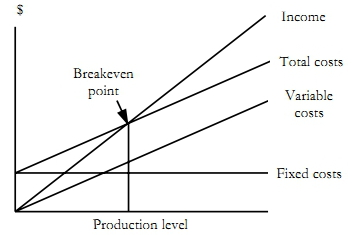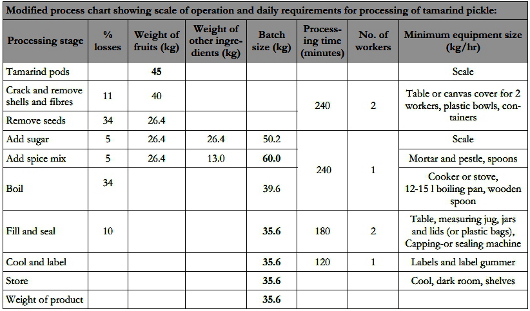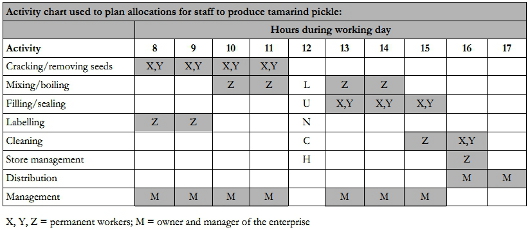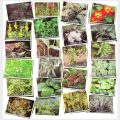How to conduct a feasibility study?
An idea for a business is not a sufficient reason to begin production straight away. It is essential to be aware of the different aspects involved in actually running the business. To reduce the risk of failure, producers should first go through the following aspects and finally develop a business plan.

Feasibility study for Small Scale Fruit Processors
1. Assess yourself as an entrepreneur
The success of any business depends largely on the entrepreneur’s personal characteristics, skills and financial situation. To be a successful entrepreneur you need to:
• Have a strong commitment to your business
• Have strong motivation to own your business
• Be able to take considered risks and to make important decisions
• Have the support of your family and friends
• Have the necessary technical skills to produce the product of your business
• Have enough business management skills, such as selling, record-keeping and costing, to run a business of your own
• Have sufficient knowledge of your line of business (post-harvest handling and storing of fruits)
• Have sufficient personal funds
2. Conduct a feasibility study
To reduce the risk of failure it is necessary to decide whether the idea is feasible. This involves carrying out a short market survey and a feasibility study. The following are the three stages of a feasibility study:
1st stage: Market feasibility
• Market research
• Selling strategy
• Expected market size/share
• Competitors
2nd stage: Technical feasibility
• Scale of production needed to meet market share
• Equipment, materials, services and labour needed for scale of production selected
• Quality control
• Distribution
3rd stage: Financial feasibility
• Startup costs
• Loan required
• Cashflow for one year (income and expenditure)
• Business development over three years
• Profitability/sustainability
Decision
2a. Market feasibility
I. Market research: The necessary steps of market research for fruit products are as follows:
• Work out the size of the potential market:
– What is the potential market area?
– Who will be the potential customers?
– What are the potential outlets?
– Who will be the competitors?
– How much of the product can be sold? (What quantities of the product are already sold and what quantities of similar products are being sold?)
– What is the seasonality of demand?
What is market research?
Market research is the process of investigating a market to find out the sales prospects for a product and how to achieve success with it. It is the set of activities necessary to obtain the information required about the market. Market research activities include:
= Consumer questionnaires;
= Tasting tests, to see if people accept the product, or which taste they prefer;
= Interviews with retailers and wholesalers.
Market research is important to avoid the failure of processing ventures.
• Research consumer attitudes towards the new products:
– What, where, and when do consumers buy?
– What are consumers’ preferences about tastes, smell, texture, etc.?
– What is the consumers’ reaction to packaging and labelling?
• Find out how the new products can be made attractive to consumers:
– What are the size units and prices of competing products, according to location?
– Where are quality weaknesses of the competition?
– Which containers are used for competing products?
– Which labelling is used by competitors and what are the legal obligations regarding label and contents?
• Identify the most appropriate option for distributing products:
– Direct to consumers? To suitable retailers in an area? To supermarkets (if sufficient quantities can be delivered)?
To wholesalers (suitable for larger processors)? To institutions and the catering trade?
• The factors to be considered in deciding on the marketing channel to use include:
– Quantities processed and quantities required by distributors, transport and payment arrangements, margins and mark-ups.
II. Market share: Estimate the proportion of the total market that the new business could expect to have (likely market share).
III. Scale of production: Once you have found information about potential consumers, their requirements and the likely share of the market that could be obtained for a new product, it is necessary to calculate the monthly and daily production required to meet that demand (see example).
Notes on calculation – example for tamarind pickle production:
Estimated market size = 14,240 kg/month
Estimated share of market = 5 %
Production required per month to meet market share = 712 kg
Production required per day @ 20 days work per month: = 35.6 kg
Minimum process through-put @ 8 hours per day = 4.5 kg/hr
The figure for the daily production rate is central to all following calculations of production capacity and investment requirements and it should therefore be as accurate as possible.
2b. Technical feasibility
Once the scale of production needed to supply the likely share of the market is known, it is necessary to assess whether production at this scale is technically feasible. Therefore you have to:
– Identify the raw material supply, their quality and buying costs;
– Identify production location and product quality;
– Identify price and price seasonality;
– Research sources and costs of services (fuel, water, electricity etc.) and other processing inputs;
– Identify sources and costs of packaging and label design;
– Identify distribution procedures to retailers or other sellers;
– Research availability of information and expertise to ensure that products are always made at the required quality;
– Research availability and costs of the equipment needed;
– Research availability of maintenance and repair costs of the equipment needed;
– Clarify labour requirements, costs and availability.
To plan the different aspects of the production process, first put together a modified process chart showing the scale of operation and daily requirements for production (see an example for the processing of tamarind pickle). The chart is used to identify the:
I. Weights of raw materials and ingredients that should be scheduled each day.
II. Number and size of equipment required to achieve the planned throughput of product.
III. Number of packages that are required each day.
IV. Number of workers and their different jobs.
I. Weights of raw materials and ingredients
The different steps to identify the weights of raw materials and ingredients are as follows:
1. Experiment with different mixes of ingredients to produce a product that has the colour, flavour, appearance etc. that consumers like. Weigh each ingredient carefully and record all weights for each formulation tried.
2. Develop a successful formulation. Take care that it is always made in exactly the same way.
3. Experiment with different varieties of fruits and the particular process that is being used to calculate the actual amount of losses (see also table showing typical losses during the processing of fruits).
4. Calculate the amount of raw materials and ingredients that are needed to produce the required weight of product each day.
Typical losses during processing:
Activities in a process – Typical losses (%)
Washing fruits = 0-10
Sorting = 5-50*
Peeling = 5-60
Slicing/dicing = 5-10
Batch preparation/weighing = 2-5
Boiling** = 5-10
Drying** = 10-20
Packaging = 5-10
Accidental spillage = 5-10
Rejected packs = 2-5
* Unsatisfactory raw materials depend on source and agreements with suppliers
** does not include evaporation losses
II. Equipment required:
Calculate the weight of food that should be processed at each stage (in kg per hour), using the process chart. Then decide on the type and size of equipment required.
– Can I afford the costs for maintenance and repairs to the equipment?
– Is the equipment too small or too large for the expected scale of production?
It is preferable to buy equipment from local suppliers because servicing and obtaining of spare parts should be faster and easier.
III. Packaging:
Decide on the type of packaging material and calculate the number of packages that is needed daily.
– Which packaging material is the most convenient and cost effective?
Take into account the technical requirements of the product for protection against light, crushing, air, moisture etc., the marketing requirements and the relative costs and availability.
IV. Number and type of workers:
Use the process chart to break down the production into different stages and then decide on the number of people needed for each stage of the process. Include tasks such as store management, quality assurance and book-keeping. Each day’s work will initially involve preparation of the raw materials and then move through processing and packaging. You can have all workers doing the same type of activity throughout the day, but it is often more efficient to distribute different jobs to each worker as the day progresses.
2c. Financial feasibility
After completing the technical feasibility study, you should have sufficient information to determine the costs involved in production. Additionally, the market survey will have supplied information about the sale price that could be achieved for the new product. You can now calculate the expected income and expenditure and the gross profit that can be achieved.
I. Start-up costs
Calculate the start-up capital and initial working capital to determine whether your savings (also called “equity”) will be sufficient to start the business. If not, a loan may be needed from a bank or other lender.
What are start-up costs?
The start-up capital is the amount of money that is needed to:
• buy or convert the facilities and equipment,
• register and licence the business,
• get the necessary hygiene certificates.
Working capital includes the costs of:
• raw materials and ingredients,
• packaging,
• staff training,
• initial product promotion, and
• staff salaries for 6 weeks that have to be made before the business starts to generate income from sales of the product.
II. Operating costs
Calculate your fixed and variable operating costs in advance based on the likely market share. If a loan is taken, the costs of repayment should be included in the fixed costs.
What are operating costs?
The costs involved in producing a fruit product can be divided into:
• Fixed costs: expenses that have to be paid even if no production takes place.
• Variable costs: expenses that depend on the amount of fruit products that are produced.

III. Income and profit
Calculate the expected sales and income using information from the market survey. The income depends on both the price of a product and the amount that is sold.
Setting the price of the product:
The correct price is important to be able to enter the market and to sell the product at a profit. There are two approaches:
1. Base price on production costs and set it to ensure that income exceeds the total costs.
2. Take into account competitors’ prices and set price of the new product at or below the price of other similar products. Don’t forget to include the profit expected by the wholesaler or retailer.
What is gross profit (or loss)?
This is the difference between the expected income and the total operating costs over the first year, including any loan repayments. Calculate the income as follows:
Income = selling price per unit x number of units sold
What is the breakeven point?
This is the production level at which the total costs will equal the total income if everything produced is sold. Calculate the breakeven point as follows:
Fixed costs / Revenue – Variable costs = Production level at breakeven point

The production level should be above the “breakeven point” for the business to be profitable. If this is not the case, you should examine the data to see if production costs can be reduced. If not, you should forget the idea and start again with a different product.
If the production level is below the breakeven point, forget the idea and choose another product
IV. Financial planning
If the gross profit indicates that the proposed fruit processing is likely to be successful, you still need to carry out a cashflow analysis:
1. Compile a table (see example), showing sales incomes and expenses on a monthly basis for the first year. Work out when you have to spend money for equipment, raw materials, employees and when you can expect to be paid for your deliveries.
2. Calculate the monthly profit or loss by subtracting the expenses from the income. This will show when there are profitable months or when a loss is expected and further loans are needed.
3. Prepare a similar table for the next two years taking into account increases in price, changes in sales and the action of competitors.
Example: Tamarind pickle production
For the production of approximately 35.6 kg of tamarind pickle, approximately 45 kg of tamarind pods are needed.

Notes on calculations:
Capacity of boiling pan
If each batch takes approximately 30 minutes to boil, 1.5 batches can be prepared per hour. In order to meet the production target of 60 kg of raw materials, yielding 35.6 kg of product every day, 4 hours are needed to prepare 6 batches of 10 kg each. The boiling pan should therefore have a capacity of 12-15 litres.
Cracking and removing of shells, fibres and seeds
It requires 8 man-hours to shell and deseed 45 kg of fruits. 2 workers are needed to complete this task in 4 hours. Since tamarind pulp can easily be stored without deterioration, the cracking and removing of shells, fibres and seeds could be carried out in advance.
Filling and sealing of bags
Each worker can fill and seal 40 jars or bags of 150 g net weight per hour. 35.6 kg produces 237 bags or jars. 2 workers are needed to complete this activity in 3 hours.

3. Prepare a business plan
Write down the results of the feasibility study. This helps to clarify and focus your ideas and to make the mistakes on paper rather than during the operation of the business. The information in the business plan will help you to make decisions on:
• Whether the business will work successfully;
• The demand for the product;
• The resources available to produce the product at the right quality and for the right price;
• Whether the business will be profitable;
• Whether a loan is needed, and if so, how much and when.
A well-prepared business plan will also help you to get a loan.
How to write a business plan?
The results of the feasibility study need to be written down in a simple, concise way to show bankers or other lending agencies that the business is carefully planned. The different steps are as follows:
1. Introduction: summarise what the product is, who the customers are and why the business is a good idea.
2. Basic information: name and address of the business, the owners, their qualifications and experience.
3. Information on the product: details of the raw materials, the production process, quality assurance, packaging etc. What is special about your product?
4. Market: potential customers and where they are located, size and value of the market, expected market share, likely expansion (or contraction) of the market, number and types of competitors, their strengths and weaknesses and their expected reactions to a new product.
5. Selling plan: distribution and sales methods, planned promotion, product cost.
6. Premises/equipment needed: location of the business, building to be used and services needed, steps taken to meet health and hygiene laws, equipment and its costs.
7. Finance: amount required for start-up and initial operation, profit and loss statement and cashflow forecast for three years, own resources that will be used, size of loan required and what it is for, security on the loan.
8. Plans for the future: objectives of the business and expectations for the next 3-5 years.
Source: Manual for Small Scale Fruit Processors © 2004 International Centre for Underutilised Crops, UK







thank you for giving important details on how to put up business..planning to have one soon..
can you give me an FS on muscovado sugar processing? Thank you!